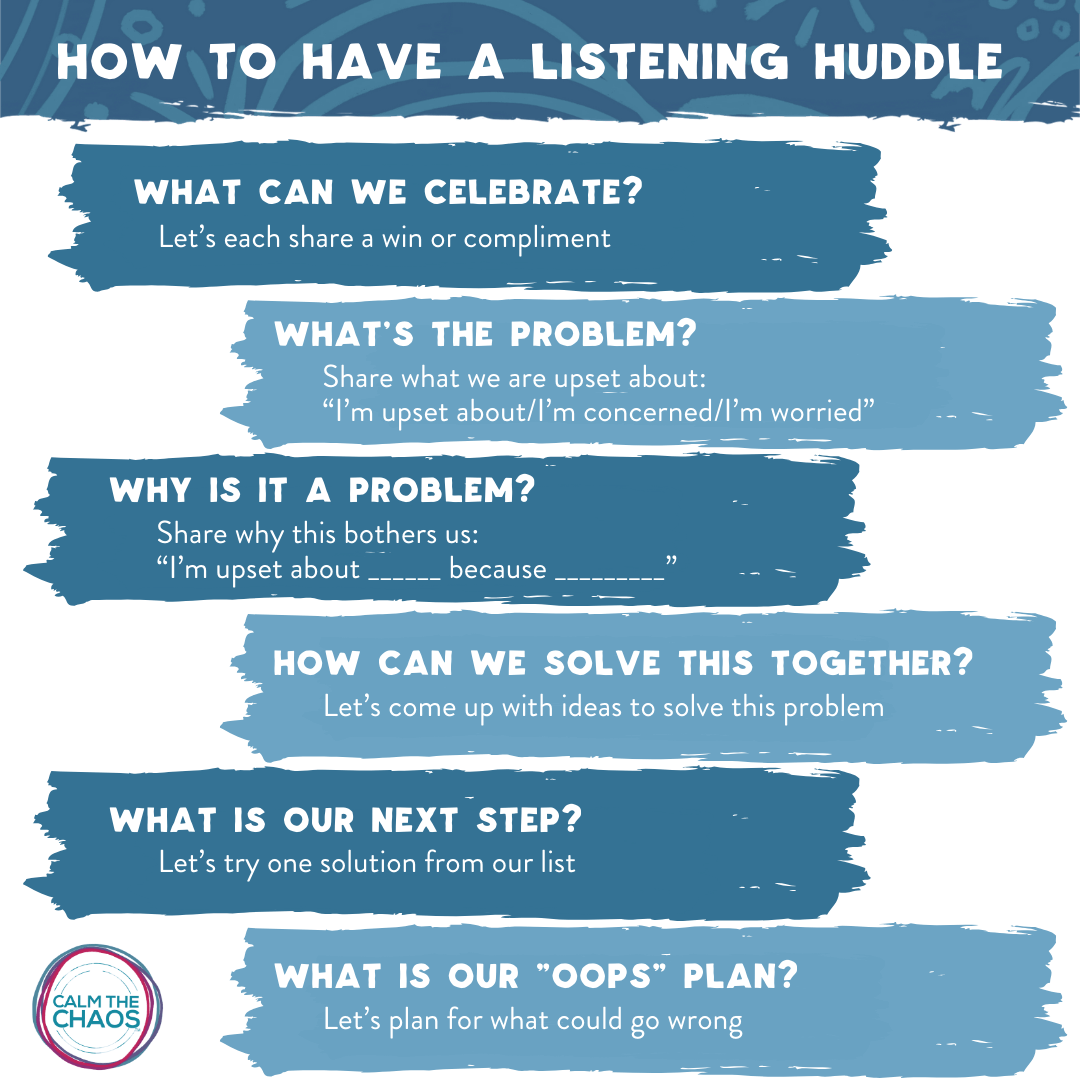Inside: How to get your kid to listen without refusal or throwing a fit (you’ll know exactly what to say to get your child out of “Refusal mode” and follow your directions)
Are your kids refusing to do ABSOLUTELY everything that you ask?
When you tell them to do something, do they flat out refuse?
Scream “NOOOO!!!!” at the top of their lungs,
Pretend like they didn’t hear you… (even though you know that they did!!!)
You find yourself repeating yourself over and over and over again… like a broken record.
Or worse, you feel like you spend the entire day walking on eggshells, so you don’t set your kid off…
Because the meltdowns are just too much!
If that is you.
You are not alone.
I totally get it.
And today I have good news for you! I’m going to share 7 phrases you can use in the moment when your kids are struggling to listen.
In addition, I want to share share a simple framework that will help you get your kids to do what you ask, WITHOUT FIGHTS!
And without:
- Refusal
- Whining
- Pouting
- Ignoring you
- Calling you names,
- or yelling “NO WAY!!!”

When I recently surveyed thousands of parents, the overwhelming response was that their biggest struggle was getting their kids to do what they ask!
- Listening,
- Doing schoolwork,
- Following rules,
- Even just following day to day activities like getting them to go outside or have a bath!
Basically, just getting them to listen! And if you’ve got a kid who is “out of the box”, meaning that they don’t fit your typical mold… You’re probably dealing with A LOT of refusal!
Before we get any further, there is something I want you to know.
You haven’t done anything wrong.
And there is nothing wrong with your child.
But here’s the thing.
We’ve got this time at home right now (and while I don’t ignore that there are a lot of challenges to parenting during a pandemic) I do know that right now is the best time to focus on getting your kids to listen. In fact, I know that if you can focus on getting to the root of the problem and creating a system that works for you and your family…
You can come out on the other side of this…
stronger and better than ever!
So when your kids look back on this time, they remember that you were able to connect and create plans together… Not that you fought all day, every day.
Why kids don’t listen in the first place…
I’m reminded of Carrie, one of my CTC students. Carrie is a military wife, and they are stationed in Italy. Just a short time ago, she was really struggling with getting her daughter to listen.
“My daughter is calling me a “big meanie”.
Whenever I ask her to do anything, she just screams at me.
She tells me to go away.
Why can’t she just listen?”
When we started digging deeper and backtracked out the outburst, I discovered that the incident actually looked a little like this:
- Her daughter was playing in her room with her toys.
- Mom walks in the room.
- Mom (Carrie) asks her daughter, “Hey, can you clean up your toys? It’s time to put our laundry away.”
- And her daughter just started screaming at her!
“You’re MEAN!!!”
“GET OUT!”
Once we started digging, we started to uncover that Carrie’s daughter already had a plan in her head.
She was playing, then Mom walked in and interrupted her plan.
Carrie expected her to stop immediately, clean up and put her laundry away.
And since her daughter didn’t have the self regulation skills yet to use the right language, she just called her a “Meanie”and refused to clean up.
Once we discovered this underlying desire and lack of self-regulation, the next step was to create a plan with Carrie’s daughter that worked for both Carrie and her daughter.
They decided on 10 more minutes of playtime and then clean up happened without a fight.

Here’s the beauty…
The next time Carrie needed her daughter to do laundry, they made a plan BEFORE play time and set a timer to make it easier on everyone involved.
And guess what?
No more screaming or name calling!
It really can be that simple. Next time your child doesn’t immediately listen or refuses, simply ask your self,
Do they already have a plan in their head?
Just think, if your spouse or neighbor came in right now while you’re reading this and they’re like: “Hey, go and mow the yard”
You would be like, “What are you talking about? Go away!! I’m doing something.”
Or if one of your kids comes in and starts tapping you on the shoulder saying right now…
“Mom,
Mom,
Mom!”
…you’re probably going to pretend to not hear them.
 Or you might say:
Or you might say:
“In a minute…”
“Hold on.”
“Wait, I want to read this.”
And you’re more than likely you might even get more frustrated and angry now that they’re not letting you do what you’re doing.
The same thing happens for our kids.
4 Steps to Get Your Child To Listen Without Ignoring, Refusal, or Constant “No’s”
I want to share an ahead of the moment plan that you can use so you don’t even have to deal with the battle in the first place, (even if you’ve got an extremely challenging child.)

It is our Calm the Chaos Framework and can be used to handle even the most challenging behaviors.
If you are not familiar, there’s 4 key elements:
- You,
- Connect,
- Understand,
- Empower.
The best part, is you really only need a sprinkle of each to make it effective.
I want to show you how to apply it specifically to listening and getting our kids to not refuse what we ask.
Step One: Swap “not listening” into “a need that isn’t being met”
The first step YOU take is to SWAP your perception of the behavior.
Instead of seeing the behavior as not listening, laziness, disrespectful, whiny, spoiled or bratty, I want you to look under the surface and see there is a reason for the behavior.
By swapping it, you can see that there is a need that’s not being met.
Not listening becomes…
- Maybe they didn’t even hear you in the first place.
- Maybe they didn’t process what you said.
- Maybe they already had a plan in their head.
- Maybe they’re just tired.
- Maybe they have something else on their mind.
When you SWAP IT…
- LAZY becomes FORGETFUL (or they need help remembering, or struggle with executive functioning.)
- DISRESPECTFUL becomes THEY ALREADY HAVE A PLAN in their head and are dead set on it and it’s hard for them to change plans in the moment.
- SPOILED becomes STANDING UP FOR THEMSELVES, but they don’t have the language to communicate that effectively yet.
- WHINEY becomes THEY NEED HELP with the skills you’re asking them to do.
Remember, All behavior is communication.
Step Two: Become the Guide
Next I want to talk about the connection. It is important as the second step in the framework to focus on connection instead of correcction.
What we’re talking about here is when our kids are:
- not listening,
- not following directions,
- refusing,
- yelling “NO” at us,
- ignoring us…
- Or pretending like they don’t hear us…
Innately, it brings up a whole lot of emotions in us and we want to react.
We want to say things like:
“Hurry up.”
“Quit whining!”
“You know better.”
“This shouldn’t take that long.”
Or “I told you 15 times!”
We end up saying things like, “You aren’t going to be able to play your iPad if you don’t do XYZ!”
But those are disconnecting phrases. They’re very corrective phrases.

Related: 2 Words to Help You Stop Yelling
One of the biggest traps we fall into when we use these phrases is that they are not clear and specific.
So if you may have a child that needs you to be explicit in your language and say.
Instead of “Stop! Stop! Stop!” Try Saying…
“I need you to stop jumping on the furniture.”
Be very specific & very clear.
Another trap I see parents often fall into is seeing connection as time together.
Often we see connection as I played a game with them, I sat with them, I cuddled with them.
BUT we spent the whole rest of the day correcting them, telling them the limit, the boundary and enforcing it.
So they aren’t able to hear all of the awesomeness that we feel about them.
Instead they are feeling like they can’t do anything right…
They feel like all you do is nag.
All you do is ask for them over and over.
And tell them what they’re doing wrong.
That’s how they hear it.
Even though that’s not how you intend it.
So you want to strive for connection instead of correction.
We want to help our kids feel
LOVED and
VALUED.

7 Empowering Phrases to Get Kids to Listen Through Connection & Problem Solving
- Let’s Take a Minute
Instead of “Hurry Up”, Try “Let’s take a minute and do it together.” This might sound like:
“Let’s take a minute and take a deep breath.”
“Let’s take a minute and find our shoes.”
“Let’s take a minute and write down what we’re going to do”
The point is… you’re slowing it down just a little bit to help your child regulate and process what was asked. - We Can Solve This Problem Together
Instead of “You already know how to do this.” You might say,
“I see that you’re not wanting to do this right now”
“How can we solve this problem together?” - Let’s Make a Plan Together
Instead of “I told you 15 times!”
Now if you said it 15 times, and they didn’t listen, is it really working?
No, it’s not.
So saying it a 16th time or a 17th time, or reminding your child that you’ve already told them a million times, isn’t going to make it any better!
So instead, I encourage you to try: “Let’s make a plan together.” - I See You are Having Trouble Getting Your Words Out
Instead of “Quit Whining”, validate your child’s concerns and feelings and help them process their struggles

- Let’s Look at Today’s Schedule
Instead of telling your child “You know what to do”, trust that something is causing them to not listen or complete the work. Maybe take a peek at the day’s plan, or break down the plan into smaller chunks. This is a great place to add visual schedules or charts. - Let’s Try Taking Baby Steps
Instead of nagging your child or telling them “This shouldn’t take two hours for you to do“, try breaking the project or the task into small steps.
“Clean your room” becomes:- Clean the floor,
- Put away laundry in the basket,
- Put the trash in the bin,
- Make your bed
- First… Then…
Instead of using ultimatums, bribery, or rewards such as “You aren’t Playing Ipad If You Don’t…”, try creating up a sequence chart for your child to follow. What comes first? What happens after?
“First we do our work, then we play on the Ipad.”
“First we read, then we do our bathtime.”
“First we eat, then we go outside.”
These phases are great to use in the moment.
BUT they are going to be much MORE POWERFUL out of the moment.
Using them out of the moment is something I call a huddle.
Step Three: Make A Plan
This is where you’re getting together with your kids and you’re trying to discover the real reason why they aren’t listening.
This is for both UNDERSTANDING & EMPOWERMENT.
For Carrie, this was understanding that her daughter already had a plan in her head, and she wasn’t wanting to clean up right now.
She had no problem putting away her laundry, she just wanted five more minutes to finish playing.
So, no matter how many times you say, don’t jump on the couch, you kids still do it.
Right?
So, ask yourself…
What is it your child is really needing?
Well, they’re needing to jump.

How can you EMPOWER them with a PLAN?
They’re needing to get that out.
They’re needing to do something.
Ask what can they do instead, and still be able to jump?
This where boundaries come in…
You are welcome to jump, but not on the couch.
So together you need to make a plan.
HINT: This isn’t in the moment.
You’re going to make that plan ahead of time.
Related: The Get Your Kid to “Do What You Ask” Kit
Make a Plan with These Three Questions:
- What is the problem?
- Why is this a problem?
- How can we solve it together?
How to Have a Listening Huddle
- What is the problem?
Example:
Well the problem is that you are screaming at me when I ask you to do something.
The problem is that you’re not cleaning up when I ask you to clean up.
The problem is, I’m having to repeat myself multiple times.
The problem is you’re not turning off electronics when I ask you. - Why is this a problem?
You have a reason it’s a problem.
But your child might not think it’s a problem at all… or they do think it’s a problem, but for a very different reason.
Ninja tip: It is important during a huddle that there is no wrong answer, that you are listening to their concern and they are listening to your concern. - How can we solve it together?
When you first do this, it’s not gonna go perfectly because they’re not used to you having these conversations with them.
But when it becomes a daily habit, your kids are going to start to trust and believe that you value their input, that you actually want to solve the problem with them, collaborate to figure out the root cause with them.
Step Four: Tweak the Plan
One of the biggest pitfalls I see parents fall into is that when a plan doesn’t work.
When their kids say:
“I don’t know”
“I don’t want to talk about it”
“I don’t want to make a plan”
Or in the moment, they break the plan.
Then, in frustration, they end up throwing your hands up and say,
“Well that didn’t work!”
And then they move on to the next quick solution.
But the key to actually seeing massive change in your family, the key to having a family that solves problems together on a daily basis, is to have conversations together, to communicate together, to enjoy time together (without the nagging).
HINT: It might not work like magic the first time.
We are looking for progress, not perfection.

Related: To the Mom That Feels Like She’s Failing
The key is that gradual tweaking.
I call this an oops plan.
Creating an oops plan is so important because:
- you are thinking ahead about the things that may go wrong.
- You’re including your kids, not only in the problem solving, but in the connection, and in the swapping.
- You’re also helping them think about how to handle it when things don’t go the way they planned, when you make mistakes.
You’re teaching them so much more than to listen.
You’re teaching them:
- How to be resilient.
- How to be confident in themself.
- How to be self aware.
- How to self regulate and self-advocate.
So every time your kids are not listening, I want you to remember:
- Swap your thoughts.
- Connect instead of correct
- Make a plan together to understand & empower
- Keep tweaking the plan, focusing on “progress not perfection”
More Resources To Get Your Child to Listen Without Throwing Fits
To help you remember exactly what to do when your kids are not listening, I’ve put together these three amazing posters on how to get your kids to listen, follow directions, and learn from home.
These posters give you tips on how to get your kids to do what you ask, without refusing, running away, or ignoring you!
There’s also 7 phrases you can say in the moment to get your kids to listen. Some amazing swaps that you can use so you can build their self-esteem by connecting instead of correcting.
You might also be wondering how to get your kids to help out around the house, and not have fights over a bedtime, or or taking their bath. I know many parents are struggling to get their children to do chores and establish daily routines right now when we are all out of our usual schedule.
So that is what I’m going to be talking about in my next blog post about how to get your kids to follow simple directions.
But right now, download your FREE Get Your Kids to Do What You Ask posters and start connecting by swapping those phrases, and getting your kids involved in making a plan!







through these tough times I being buying some toys to keep my three little siblings entertained, this is just one website that I used, but there are a lot of more, I just prefer that my siblings distract themselves with toys than with a phone, so I encourage all the parents, grandparents, uncles, aunts, brothers and sisters to give to our little ones a toy as a present, I hope this helps.
https://www.entertainmentearth.com/s/star-wars/t?id=MA-006061807“
Pingback: How to Go From 24-7 Sibling Fighting to Hours of Unsupervised Play with These Simple Steps